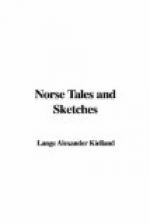Meanwhile one begins to hear a light trotting over the paper; they are leaping.
Some few individuals sit firmly and gracefully through it all, and come out on the other side ‘standing for Laud.’ Others think that leaping straight is too easy; therefore, they turn in the air and alight with backs first. These also get through, but backwards; and it is said that their agility does not win from the judges its deserved meed of appreciation.
Again, others leap, but miss the hoop. They spring underneath, to one side—some even high over the top, alighting safe and sound on the other side. These latter generally find the paper extremely simple, and continue the wild ride quite unconcernedly.
But if one is not fond of riding, and has had no practice in leaping, he is much to be pitied—unless, indeed, he has a monkey on page 496.
I do not know how many hoops I had passed when I found myself face to face with the process-paper.
It was an unhealthy life that we then led: leaping by day and reading by night. I sat at midnight half-way through Schweigaard’s Process, alternately putting my head out of the window and into the washhand basin, and, between whiles, rushing like a whirlwind through the withered leaves of the musty volume.
However, even the most violent wind must eventually fall; and, indeed, this was my heartfelt wish. But the juridical momentum was strong within me. I sat stiffly, peering and reading for the eleventh time: ’One might thus certainly assume’—’One—might—thus—certainly,’— combine the useful with the agreeable—and lean back—a little in the chair. I can read just as well; the lamp doesn’t bother me in the least. ‘One—might—thus—’
But all manner of non-juridical images rose up from the book, entwined themselves about the lamp, and threatened to completely overshadow my clear legal brain. I could yet dimly see the white paper. ’One—might— thus—’. The rest disappeared in a myriad of small dark characters that flowed down the closely-printed pages; in dull despair my eyes followed the stream, and then I saw, towards the bottom of the right-hand page, a face.
It was a monkey that was drawn on the margin. It was excellently drawn, I thought, the brown colouring of the face being especially remarkable. I am ashamed to say that my interest in this work of art proved stronger than Schweigaard himself. I roused myself a little, and leant forward in order to see better.
By turning the leaf, I discovered that the remarkable brown colouring of the face was due to the fact that the whole monkey, after all, was only a coffee-stain. The artist had merely added a pair of eyes and a little hair; the genial expression of the picture was really to be credited to the individual who had spilt the coffee.
‘Cucumis couldn’t draw,’ thought I; that I knew. ’But, by Jove! he could do his process!’




